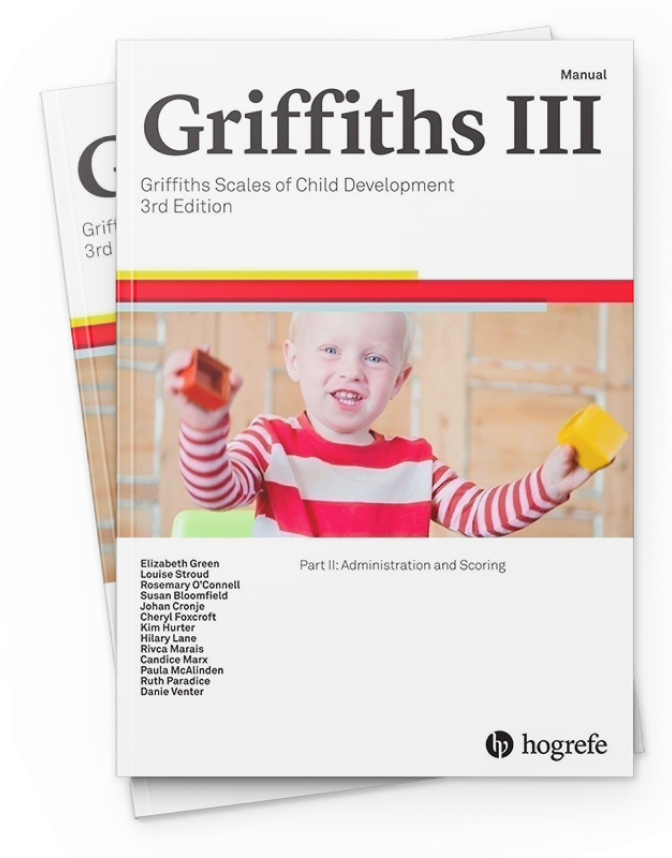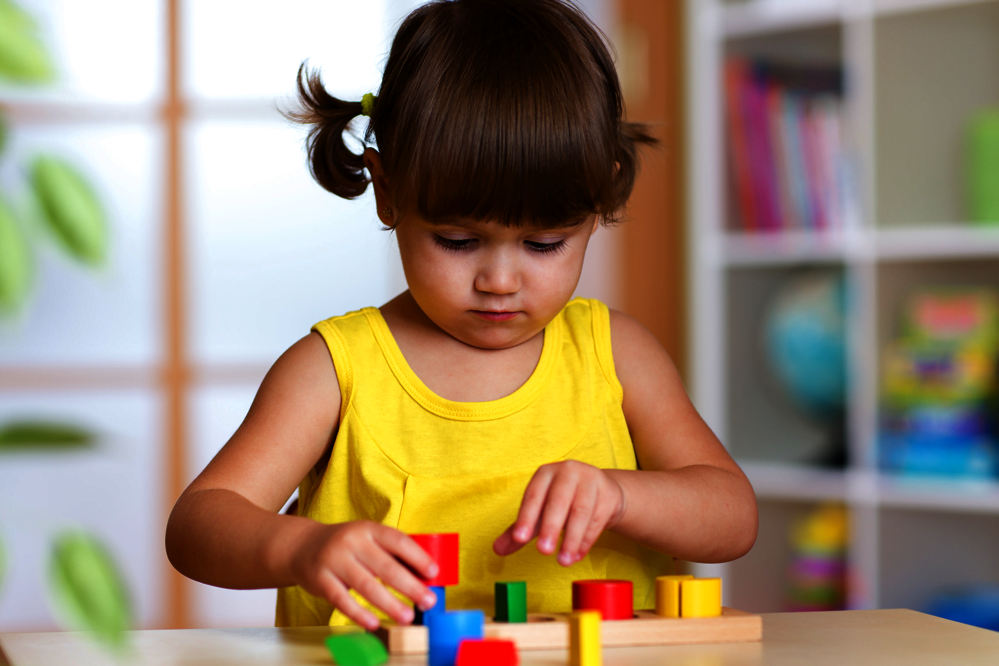
Griffiths Scales of Child Development 3rd Edition [GRIFFITHS-III]
The latest edition of the Griffiths Scales of Child Development. Griffiths III represents an evolution in developmental assessment, based on the latest research and theory, and building on the best of the past. Provides an overall measure of a child’s development, an individual profile of strengths and weaknesses across 5 areas.
For ages: Birth (1 month) to 6 years (72 months)
Format: Paper-and-Pencil
Administration Time: Approx. 60 minutes
Scoring: Hand Scored
Authors: Elizabeth Green, Louise Stroud, Susan Bloomfield, Johan Cronje, Cheryl Foxcroft, Kim Hunter, Hilary Lane, Rivca Marais, Paula McAlinden, Rosemary O’Connell, Ruth Paradice, Candice Marx, Danie Venter
Freight: Freight is charged at cost with a quotation provided for approval
Special training required. Please read below.
Books & Workbooks
Click to browse products
Printed Manuals
Click to browse products
Printed Kits
Click to browse products
Griffiths III Record Books (10) & Drawing Booklets (10) – Packet
Griffiths III Record Books (Pack of 10)
Griffiths III Manual Part I
Griffiths III Manual Part II
Griffiths III Manual Part III
Griffiths III Kit
Griffiths III represents an evolution in developmental assessment, based on the latest research and theory, and building on the best of the past. Griffiths III is a comprehensive, child-friendly developmental measure for continuous use from birth (1 month) to 5 years and 11 months (71 months).
The Association for Research in Infant and Child Development (ARICD) in the UK has completed a thorough re-standardisation of the Griffiths Mental Development Scales (GMDS) – described as “Gold Standard” in child development testing. The standardisation in 2015 used a representative sample from UK and Ireland.
Griffiths III is a substantially new and improved single kit, reflecting contemporary knowledge of child development. More than 80% of this test has been redesigned, taking account of clinician feedback, to make a more streamlined, modern assessment. The administration sequence has been made straightforward and practical for users. The administration time to complete the Griffiths III is approximately 60 minutes. All equipment may be easily cleaned, is child-friendly and has been designed to keep small children engaged and at ease.
Griffiths III provides an overall measure of a child’s development, as well as an individual profile of strengths and needs across five areas:

- Foundations of Learning – assesses critical aspects of learning during the early childhood years.
- Language and Communication – measures overall language development, including expressive language, receptive language and (to a lesser extent) use of language to communicate socially with others.
- Eye and Hand Coordination – considers fine motor skills, manual dexterity and visual perception skills.
- Personal-Social-Emotional – measures constructs relating to the child’s developing sense of self and growing independence, interactions with others, plus many aspects of emotional development.
- Gross Motor – assesses postural control, balance and gross body coordination, among other abilities.
Outdated test items have been revised according to the latest developmental, paediatric, psychological and neurological research.
Griffiths III may be used by psychologists and paediatricians, plus other allied health professionals, for a variety of purposes in a range of applied settings. Assessing a child’s developmental profile and level helps to identify if a child is developing appropriately for their age or whether difficulties in specific areas could be linked to a specific developmental or learning disorder.
Griffiths III may assist in tracking and monitoring development over time, and planning for and measuring the impact of interventions. It may also provide valuable information to inform decisions about future placement and management of the child.
The Griffiths III Kit
The kit comes in a durable carrying case and includes the following components:
- Manual Part I: Theoretical and Technical
- Manual Part II: Administration, Scoring, Interpretation and Feedback
- Manual Part III: Normative Information
- Record Book with Analysis Sheet (10 pack)
- Drawing Booklet (10 pack)
- Test Equipment
- E-learning package registration information (for previously trained users of the Griffiths)

HOW CAN I START USING GRIFFITHS III?
Griffiths III Training
All Griffiths III materials are only sold to child development professionals who have undertaken additional training specifically on the Griffiths III. Training is managed by the UK based Association for Research in Infant and Child Development (ARICD), a not-for-profit organisation that developed the Griffiths III. This link will take you to the ARICD world-wide training landing page where you can search for training courses that might be convenient for you to attend. You may also contact: Dr Brad Jongeling – Consultant Paediatrician, Medical HOD, Child Development Services, Joondalup Child Development Services, JOONDALUP WA 6027. T: 08 9400 9533 F: 08 9400 9525. Australian Coordinator for ARICD & Griffiths III Interest Group. – email: brad.jongeling@health.wa.gov.au
existing users
Trained users must provide proof of previous certification to PAA before we may allow purchase of new Griffiths III.
There will be no ‘upgrade kit’ and trained users of the Griffiths will need to simply undergo a conversion course via a free online e-learning package, for which registration information is included in the new Griffiths III kit. Users will be required to pass a short test at the end of the e-learning, after which Griffiths III certification will be provided. This online training module is from The Association for Research in Infant and Child Development (ARICD) in the UK.
new users
As mentioned above, courses for new Users are now available from The Association for Research in Infant and Child Development (ARICD) in the UK. For new users of the Griffiths there will be an e-module to complete, plus a new face-to-face training course which is expected to be 3 days rather than the current 5. Proof of Griffiths III certification must be provided to PAA to allow purchase of Griffiths III.
In this article, Michael Gee, MAPS (Psychologist) and Karen Gee, MAPS MCEDP (Educational and Developmental Psychologist) expand on the refreshed and evolved Griffiths III:
ARTICLE: Evolution of the Griffiths: Differences between the Griffiths III and the GMDS-ER
By Michael Gee MAPS (Psychologist) and Karen Gee MAPS MCEDP (Educational and Developmental Psychologist)
The differences between the GMDS-ER and the new Griffiths III represent an evolution in developmental assessment based on the latest research and theory, and building on the best of the past.
Wechsler (1958) articulated that observing individuals while they solve problems provides an opportunity to gather qualitative, clinical information. This followed in the tradition of the Method Clinique, developed by pioneers such as Jean Piaget and Ruth Griffiths (1954), who observed children at play and in solving problems within their environment. Not only did this ecological systems approach predate Bronfenbrenner (1979), it is reflected in the new protocols where more space has been allocated for observations which may be quantified in terms of samples of behaviour and language. In addition, more advanced protocols will be developed to augment the clinician’s observations and analysis.
The new Griffiths III also reflects the cumulative, quantifiable feedback from clinicians in the field, advances in statistical analysis and norming and research into children’s development (from the neurodevelopmental to emotional regulation and play). But the Griffiths III also represents a significant development; more than 80 percent of the Griffiths III has been redesigned. It is more streamlined, in terms of ease of administration (fewer disparate items, many of which have been integrated into the ‘Quiet Book’), reduced in terms of the number of items (by 36%) and the age range to be evaluated (birth to 5 years 11 months of age), modernised in terms of the stimulus materials and more integrated in terms of the norms structure and use of protocols.
The administrative sequence has been made straightforward. Moreover, the materials may be cleaned.
There will not be separate norms for the 0 to 2 years of age cohort and another for the 2+ years of age cohorts in the Griffiths III so it will constitute a seamless assessment. In addition, the new norms will address the ‘Flynn effect’ and minimise cultural bias. At the same time the age format structure will be reintroduced from earlier versions. Moreover, the domains of assessment have been reduced from 6 to 5.
The Foundations of Learning Subscale (A) has replaced the Performance and Practical Reasoning Subscales of the GMDS-ER. It will evaluate various aspects of cognition such as different types of attention, processing speed, aspects of executive function such as flexibility, dimensions of reasoning, curiosity and creativity, organising information and planning solutions, concept formation and sequencing thought (Stroud, 2016). It also incorporates various aspects of visual and auditory long-term and short-term memory as well as play (Stroud, 2016), a by-product of cognitive, social and emotional development. Further, it taps visual sequencing in the Picture Arrangement and Series sub-tests.
The Language and Communication Subscale (B) has been refined so that differences between expressive and receptive Language on the one hand and syntactic, semantic and pragmatic language (Paradice, 2016) on the other have been made more explicit and amenable to further consideration. Memory has also been incorporated into the Scale. In conjunction with the Personal, Social Emotional Scale (Subscale D), it will provide useful information in the differential diagnosis of certain neurodevelopmental disorders.
The Eye and Hand Coordination Subscale (C) has been restructured so that it is more contemporary and fun to use by children and in line with the latest research on neuro-physical development (Forssberg, 1998). New tasks include putting rings on a pole (a prelude and form of scaffolding for bead threading), using playdough to make shapes (which also provides information on tactile sensitivities), using Connector Blocks to evaluate strength, imitating finger movements and using their index finger to track ‘trails’ and employing ‘Construction type pieces’ to construct 3 dimensional objects and tap bilateral asymmetric coordination (Bloomfield, 2016).
The Personal, Social Emotional Subscale (D) has undergone a major revision. It breaks personal-social-emotional development into a finer grained analysis so that it transcends mere audits of adaptive behaviour. It measures the capacity to ‘read’ facial expressions’, empathy, ‘theory of mind’ and ‘perspective taking’, self-concept and capacity for self-evaluation at the 5 year 11 months of age level and moral reasoning (Lane, 2016).
The Gross Motor Subscale (E) has been modernised, safety has been accentuated and the new constructs of Postural Development and Motor Sequencing have been incorporated in the new scale (Green, 2016).
Overall, the new Griffiths III represents, conceptually, a significant advance in developmental assessment which may be used with a range of populations and contribute in a practical way to the learning plans of those in need.
In the final analysis, assessment and diagnosis is dependent on the clinician’s and researcher’s capacity to carry out a comprehensive investigation, where data is collected from many sources (including using assessment tools), various hypotheses explored and the professional’s nuanced clinical skills and judgement are used to maximise the intervention outcomes for the child, the family, and other institutions, such as schools. Its strength is that it is a reliable tool that has, and continues to, yield efficacious results with special populations from birth to 5 years 11 months of age and informs interventions in the form of Individual Educational Plans (IEPs).
References:
Bloomfield, S. (2016). Subscale C: Eye and Hand Coordination. PowerPoint Presentation on the developments in the Griffiths III on the ARICD site.
Bronfenbrenner, U. (1979). The ecology of human development: Experiments by nature and design. Cambridge, MA: Harvard University Press.
Forssberg, H., (1998) The Neurophysiology of Manual Skill Development in The Psychobiology of the Hand Ed. Connelly, K.J., Clinics in Developmental medicine No. 147 pp 100-105 Mac Keith Press
Flynn, J. R. (2009). What is intelligence: Beyond the Flynn Effect (expanded paperback ed.). Cambridge: Cambridge University Press. (The term was originally coined by Herrnstein and Murray)
Green, E. (2016). Subscale E: Gross Motor. PowerPoint Presentation on the developments in the Griffiths III on the ARICD site.
Griffiths, R. (1935). Imagination in early childhood. London: Routledge.
Griffiths, R. (1954). The abilities of babies, 0-2 years. London: University of London Press.
Lane, H. (2016). Subscale D: Personal, Social, Emotional. PowerPoint Presentation on the developments in the Griffiths III on the ARICD site.
Paradice, R. (2016). Scale B: Language and Communication. PowerPoint Presentation on the developments in the Griffiths III on the ARICD site.
Stroud, L. (2016). Scale A: Foundations of Learning. PowerPoint Presentation on the developments in the Griffiths III on the ARICD site.
Wechsler, D. (1958). The measurement and appraisal of adult intelligence (4th ed.). Baltimore, MD: Williams & Witkins.



